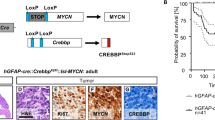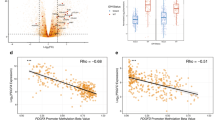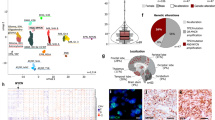Abstract
p53-germline mutations located in the core DNA-binding domain have been associated with a more dominant tumor penetrance especially for breast cancer and brain tumors. We previously reported an unusual accumulation of CNS tumors associated with a unique p53 germline mutation, Y236Δ (deletion of codon 236). To test whether this tissue-specific tumor predisposition reflects a gain-of-function activity of Y236Δ, we generated transgenic mice expressing Y236Δ in astrocytes using the regulatory elements of the glial fibrillary acidic protein (GFAP) gene. After transplacental exposure to N-ethyl-N-nitrosourea (25 mg/kg BW) brain tumors developed in 18% (7/39) of GFAP-Y236Δ transgenic p53+/− mice, while in p53+/− mice the incidence was 28% (11/40) (P>0.3). However, the mean tumor latency for GFAP-Y236Δ/p53+/− mice was significantly shorter than for p53+/− mice, with 19.9 weeks vs 31.6 weeks (P=0.039), respectively. Taken together, cell specific expression of Y236Δ results in an acceleration of tumor progression but does not confer a higher tumor penetrance. Conceivably, the transdominant effect of Y236Δ provided a growth advantage early in the progression of neoplastic cells, since the endogenous p53 wild-type allele was lost in all brain tumors independent of the genotype. This reflects well observations from human astrocytic neoplasms with p53 mutations.
This is a preview of subscription content, access via your institution
Access options
Subscribe to this journal
Receive 50 print issues and online access
$259.00 per year
only $5.18 per issue
Buy this article
- Purchase on Springer Link
- Instant access to full article PDF
Prices may be subject to local taxes which are calculated during checkout





Similar content being viewed by others

References
Baker SJ, Markowitz S, Fearon ER, Willson JKU and Vogelstein B. . 1990 Science 249: 912–915.
Birch JM, Blair V, Kelsey AM, Evans DG, Harris M, Tricker KJ and Varley JM. . 1998 Oncogene 17: 1061–1068.
Chène P, Mittl P and Grütter M. . 1997 J. Mol. Biol. 273: 873–881.
Chène P, Ory K, Rüedi D, Soussi T and Hegi ME. . 1999 Int. J. Cancer 82: 17–22.
Crook T, Marston NJ, Sara EA and Vousden KH. . 1994 Cell 79: 817–827.
Denlinger RH, Koestner A and Wechsler W. . 1974 Int. J. Cancer 13: 559–571.
Di Cristofano A, Pesce B, Cordon-Cardo C and Pandolfi PP. . 1998 Nat. Genet. 19: 348–355.
Dittmer D, Pati S, Zambetti G, Chu S, Teresky AK, Moore M, Finlay C and Levine AJ. . 1993 Nat. Genet. 4: 42–45.
Donehower LA, Harvey M, Slagle BL, McArthur MJ, Montgomery Jr CA, Butel JS and Bradley A. . 1992 Nature 356: 215–221.
Ekstrand AJ, James CD, Cavenee WK, Seliger B, Petterson RF and Collins VP. . 1991 Cancer Res. 51: 2164–2172.
Forrester K, Lupold SE, Ott VL, Chay CH, Band V, Wang XW and Harris CC. . 1995 Oncogene 10: 2103–2111.
Fraser H. . 1971 J. Pathol. 103: 266–270.
Friedlander P, Haupt Y, Prives C and Oren M. . 1996 Mol. Cell. Biol. 16: 4961–4971.
Fulci G, Labuhn M, Maier D, Lachat Y, Hausmann O, Hegi ME, Janzer RC, Merlo A and Van Meir EG. . 2000 Oncogene 19: 3816–3822.
Graeber TG, Osmanian C, Jacks T, Housman DE, Koch CJ, Lowe SW and Giaccia AJ. . 1996 Nature 379: 88–91.
Groot PC, Moen CJ, Dietrich W, Stoye JP, Lander ES and Demant P. . 1992 FASEB J. 6: 2826–2835.
Gualberto A, Aldape K, Kozakiewicz K and Tlsty TD. . 1998 Proc. Natl. Acad. Sci. USA 95: 5166–5171.
Harvey M, McArthur MJ, Montgomery CA, Bradley A and Donehower LA. . 1993 FASEB J. 7: 938–943.
Hegi ME, Klein MA, Rüedi D, Chène P, Hamou M-F and Aguzzi A. . 2000 Cancer Res. 60: 3019–3024.
Hegi ME, zur Hausen A, Rüedi D, Malin G and Kleihues P. . 1997 Int. J. Cancer 73: 57–63.
Hermanson M, Funa K, Koopmann J, Maintz D, Waha A, Westermark B, Heldin C-H, Wiestler OD, Louis DN, von Deimling A and Nistér M. . 1996 Cancer Res. 56: 164–171.
Hollstein M, Shomer B, Greenblatt M, Soussi T, Hovig E, Montesano R and Harris CC. . 1996 Nucleic Acids Res. 24: 141–146.
Ichimura K, Schmidt EE, Goike HM and Collins VP. . 1996 Oncogene 13: 1065–1072.
Kastan MB, Onyekwere O, Sidransky D, Vogelstein B and Craig RW. . 1991 Cancer Res. 51: 6304–6311.
Kemp CJ, Donehower LA, Bradley A and Balmain A. . 1993 Cell 74: 813–822.
Kleihues P and Cavenee WK. . 2000 Pathology & Genetics. Tumours of the nervous system. IARCPress, Lyon.
Kleihues P and Ohgaki H. . 1999 Neurol. Oncol. 1: 44–51.
Kleihues P, Schäuble B, zur Hausen A, Estève J and Ohgaki H. . 1997 Am. J. Pathol. 150: 1–13.
Lavigeur A, Maltby V, Mock D, Rossant J, Pawson T and Bernstein A. . 1989 Mol. Cell. Biol. 9: 3982–3991.
Levine AJ. . 1997 Cell 88: 323–331.
Li FP, Fraumeni JF, Mulvihill JJ, Blattner WA, Dreyfuss MG, Tucker MA and Miller RW. . 1988 Cancer Res. 48: 5358–5362.
Liu G, McDonnell TJ, Montes De Oca Luna R, Kapoor M, Mims B, El-Naggar AK and Lozano G. . 2000 Proc. Natl. Acad. Sci. USA 97: 4174–4179.
Lübbe J, von Ammon K, Watanabe K, Hegi ME and Kleihues P. . 1995 Brain Pathol. 5: 15–23.
Luongo C, Moser AR, Gledhill S and Dove WF. . 1994 Cancer Res. 54: 5947–5952.
Maddalena A, Hainfellner J, Hegi ME, Glatzel M and Aguzzi A. . 1999 Brain Pathol. 9: 627–637.
Maier D, Zhang Z, Taylor E, Hamou M-F, Gratzl O, Van Meir EG, Scott RJ and Merlo A. . 1998 Oncogene 16: 3331–3335.
Malkin D, Li FP, Strong LC, Fraumeni JJ, Nelson CE, Kim DH, Kassel J, Gryka MA, Bischoff FZ, Tainsky MA and Friend SH. . 1990 Science 250: 1233–1238.
Marino S, Vooijs M, van Der Gulden H, Jonkers J and Berns A. . 2000 Genes Dev. 14: 994–1004.
Mollenhauer J, Wiemann S, Scheurleen W, Korn B, Hayashi Y, Wilgenbus KK, von Deimling A and Poustka A. . 1997 Nature Genet. 17: 32–39.
Mucke L, Oldstone MB, Morris JC and Nerenberg MI. . 1991 New Biol. 3: 465–474.
Oda H, Zhang S, Zurutani N, Shimizu S, Nakatsuru Y, Aizawa S and Ishikawa T. . 1997 Cancer Res. 57: 646–650.
Patel AC, Anna CH, Foley JF, Stockton PS, Tyson FL, Barrett JC and Devereux TR. . 2000 Carcinogenesis 21: 1691–1700.
Pennica D, Goeddel DV, Hayflick JS, Reich NC, Anderson CW and Levine AJ. . 1984 Virology 134: 477–482.
Rosenberg JE, Lisle DK, Burwick JA, Ueki K, von Deimling A, Mohrenweiser HW and Louis DN. . 1996 Oncogene 13: 2483–2485.
Sato K, Sato A, Aoto M and Fukami Y. . 1995 Biochem. Biophys. Res. Commun. 215: 1078–1087.
Shaulian E, Zauberman A, Milner J, Davies EA and Oren M. . 1993 EMBO J 12: 2789–2797.
Steck PA, Pershouse MA, Jasser SA, Yung WKA, Lin H, Ligon AH, Langford LA, Baumgard ML, Hattier T, Davis T, Frye C, Hu R, Swedlund B, Teng DHF and Tavtigan SV. . 1997 Nature Genet. 15: 356–362.
Timme TL and Thompson TC. . 1994 Biotechniques 17: 461–463.
Toggas SM, Masliah E, Rockenstein EM, Rall GF, Abraham CR and Mucke L. . 1994 Nature 367: 188–193.
Varley JM, Evans DGR and Birch JM. . 1997 Br. J. Cancer 76: 1–14.
Vital A, Bringuier PP, Huang H, San Galli F, Rivel J, Ansoborlo S, Cazauran JM, Taillandier L, Kleihues P and Ohgaki H. . 1998 J. Neuropathol. Exp. Neurol. 57: 1061–1069.
von Deimling A, Eibl RH, Ohgaki H, Louis DN, von Ammon K, Petersen I, Kleihues P, Chung RY, Wiestler OD and Seizinger BR. . 1992 Cancer Res. 52: 2897–2990.
Watanabe K, Tachibana O, Sato K, Yonekawa Y, Kleihues P and Ohgaki H. . 1996 Brain Pathol. 6: 217–224.
Weissenberger J, Steinbach JP, Malin G, Spada S, Rülicke T and Aguzzi A. . 1997 Oncogene 14: 2005–2013.
Zindy F, Eischen CM, Randle DH, Kamijo T, Cleveland JL, Sherr CJ and Roussel MF. . 1998 Genes Dev. 12: 2424–2433.
Acknowledgements
We are indebted to L Donehower for providing the p53-deficient mice and to L Mucke for the GFAP-promoter construct. We thank M König, B Pfister, L Vlk, B Odermatt, S Trepey and M-F Hamou for histology, and Ch El-Ariss for technical assistance. We appreciated the helpful discussions with J Hainfellner and P Kleihues. We thank E Van Meir and N de Tribolet for their support, and S Marino, and R Iggo for critical reading of this manuscript. This project was supported by grants of the Swiss National Science Foundation (to ME Hegi and A Aguzzi, and to E Van Meir and ME Hegi), the Swiss Cancer League (to ME Hegi and N de Tribolet), the Swiss Cancer League/Cancer League of the Canton of Aargau (to A Aguzzi), and the Deutsche Forschungsgemeinschaft (DFG) (to MA Klein).
Author information
Authors and Affiliations
Rights and permissions
About this article
Cite this article
Klein, M., Rüedi, D., Nozaki, M. et al. Reduced latency but no increased brain tumor penetrance in mice with astrocyte specific expression of a human p53 mutant. Oncogene 19, 5329–5337 (2000). https://doi.org/10.1038/sj.onc.1203941
Received:
Revised:
Accepted:
Published:
Issue Date:
DOI: https://doi.org/10.1038/sj.onc.1203941
Keywords
This article is cited by
-
20 years studying p53 functions in genetically engineered mice
Nature Reviews Cancer (2009)
-
Neural precursor cell apoptosis and glial tumorigenesis following transplacental ethyl-nitrosourea exposure
Oncogene (2001)


